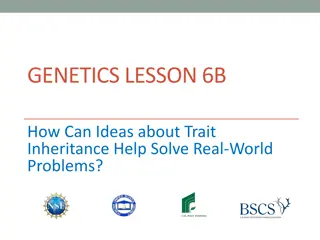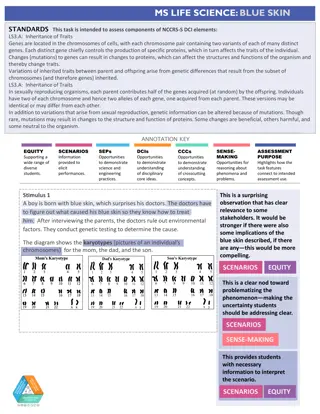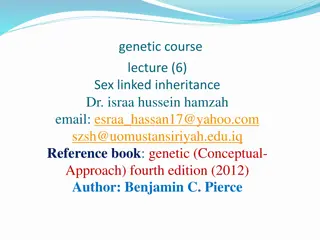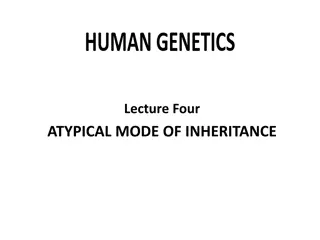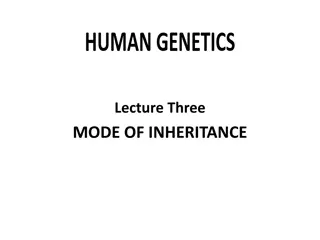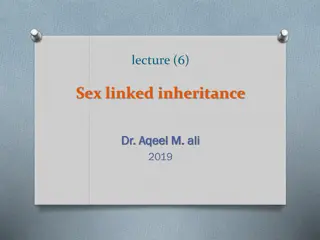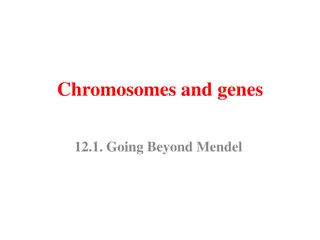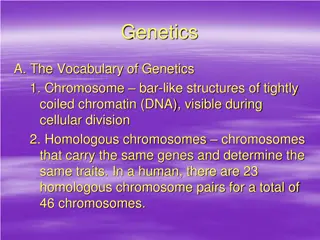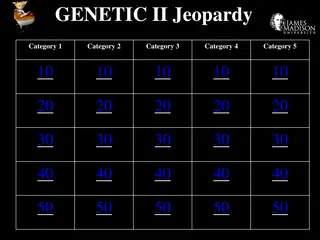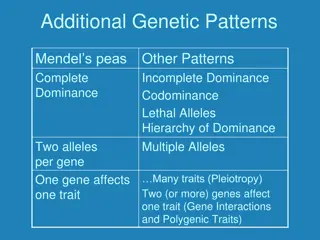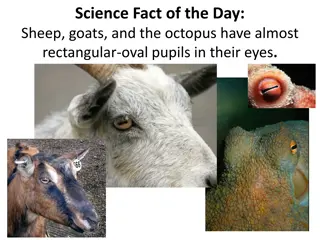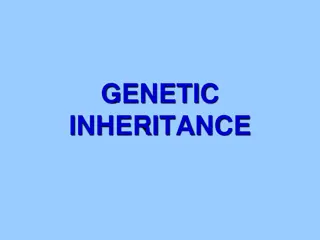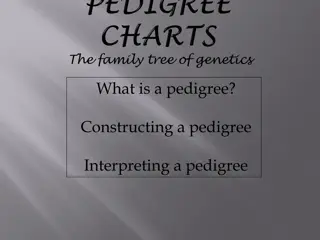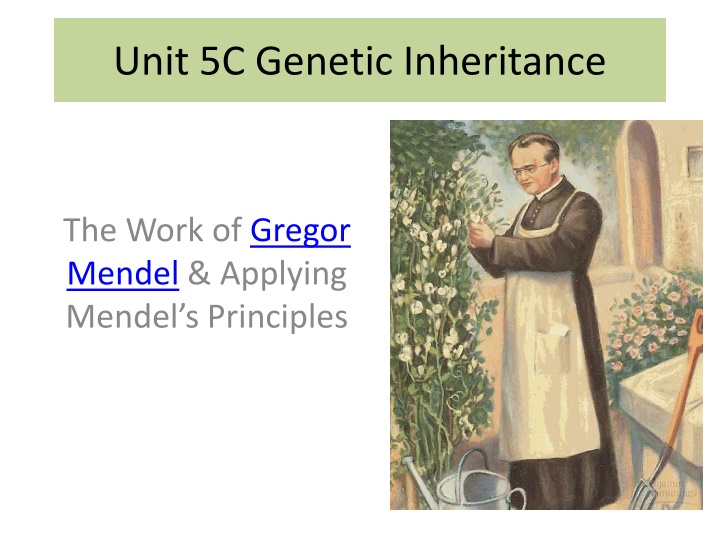
Gregor Mendel and the Study of Genetic Inheritance
Explore the foundational work of Gregor Mendel in genetic inheritance, where he studied pea plants to establish principles that revolutionized biology. Discover the relevance of heredity, genetics, traits, and cross-pollination in understanding offspring characteristics.
Download Presentation

Please find below an Image/Link to download the presentation.
The content on the website is provided AS IS for your information and personal use only. It may not be sold, licensed, or shared on other websites without obtaining consent from the author. If you encounter any issues during the download, it is possible that the publisher has removed the file from their server.
You are allowed to download the files provided on this website for personal or commercial use, subject to the condition that they are used lawfully. All files are the property of their respective owners.
The content on the website is provided AS IS for your information and personal use only. It may not be sold, licensed, or shared on other websites without obtaining consent from the author.
E N D
Presentation Transcript
Unit 5C Genetic Inheritance The Work of Gregor Mendel & Applying Mendel s Principles
Heredity and Genetics Heredity- the delivery of characteristics from parent to offspring Genetics- the scientific study of heredity The Modern study of genetics was founded by a monk named Gregor Mendel in the mid- 1800 s Mendel studied genetics in pea plants
Mendel Changed Biology Forever by Working in the Monastery Garden!! Worked with garden peas- a Model System Convenient to study Easy to grow Produce many offspring quickly Info from peas can tell us about other organisms Some other model systems are fruit flies, bacteria, mice, monkeys, etc.
A Little Bit About Peas Pea plants have flowers Pea flower Anatomy: Anther- creates pollen which contains sperm Ovary- Contains eggs Stigma- receives pollen to bring to the egg cells
Fertilization in Peas Normally the pollen of the pea plant will fertilize the eggs of the SAME pea plant (self pollination) This will always produce offspring identical to the parent plant- true-breeding plants Mendel decided to cross pea plants To cross means to cause one organism to reproduce with another Mendel used a paint brush to take pollen from one plant and place it on the stigma of a different pea plant
Setting Up A Cross P Generation (parental) the original pair of plants F1Generation ( filial meaning son or daughter)- the offspring of the P generation F2 Generation- the offspring of a self- pollinated F1.
Traits Specific characteristics of an individual Example: in pea plants- tall or short, round or wrinkled In humans, brown eyes, blue eyes
The Traits Mendel Studied Mendel crossed parents with opposite traits to study the following 7 traits in the offspring: A- flower on side T- flower at the end The offspring produced by crossing parents with different traits are called hybrids
Setting Up A Cross P Generation (parental) the original pair of plants F1Generation ( filial meaning son or daughter)- the offspring of the P generation
Mendels F1 Results All F1 offspring had the trait of only one parent The trait of the other parent seemed to have disappeared
Two Conclusions From These Data 1. An individual s characteristics are determined by factors that are passed from one parental generation to the next. - Today, these factors are called genes - Each Trait Mendel studied was controlled by a single gene - Each gene has two contrasting varieties - The different forms of the gene are called alleles - Example: the gene for height comes in alleles for tall and short.
Two Conclusions From These Data (cont.) 2. The Principle of Dominance- some alleles are dominant and some are recessive - Organisms carry two alleles for each trait - Only one dominant allele needs to be present for that trait to be expressed (it dominates over the recessive allele) - Two copies of the recessive allele must be present for that trait to be expressed. TT Tt One dominant and one recessive allele tt Two recessive alleles Two dominant alleles
Segregation After seeing the trait of only one parent show up in the F1, Mendel wanted to know if the other parent s trait had disappeared. He allowed the F1 hybrid plants to self-pollinate. The offspring of the F1 cross are called the F2 generation (second filial) Cross Pollination Self Pollination
Segregation (cont.) Cross Pollination The recessive traits reappeared in the F2 generation 25% of the F2 had the recessive trait He then asked, why did these recessive traits disappear in the F1 generation only to reappear in the F2 generation? Self Pollination
Segregation During gamete formation, the pair of alleles for each trait will segregate, so that each gamete carries only 1 allele
Two Gametes Come Together During Fertilization When the gametes of the F1 come together in the F2, new combinations of alleles are created The recessive trait will show up when two recessive alleles come together Two recessive alleles leads to the recessive trait
Allele Combinations Homozygous- organisms with two identical alleles for a particular gene (Ex: TT, tt) Heterozygous- organisms that have two different alleles for the same gene (Tt)
Genotype and Phenotype Genotype- the genetic makeup of an organism (Ex: TT) Phenotype- the observable characteristic or trait (Ex: Tall) A plant with the genotype _________ has a phenotype of short. A plant with the genotype of Tt has a phenotype of ____________.
Using Punnett Squares Probability can be used to predict the outcome of genetic crosses. Example: Parent 1 is TT Parent 2 is tt Both possible gametes from Parent 1 T T t Both possible gametes from Parent 2 t
Genotypes: What percent of the offspring are homozygous dominant? What percent of the offspring are heterozygous? What percent of the offspring are homozygous recessive? Phenotypes: What percent are tall? What percent are short?
Test Cross Used to determine if an individual with the dominant trait is homozygous or heterozygous Example: A pea plant is tall. Is its genotype TT or Tt? Cross the tall pea plant with a short pea plant (tt) to see the phenotypes of the offspring. have the dominant phenotype then the parent was TT If all offspring
Independent Assortment Mendel wanted to know if the segregation of one pair of alleles affects the segregation of another pair Ex: if a parent pea plant is round and yellow does its off have to have both round and yellow also, or can they have round and green, or wrinkles and yellow? Experiments testing how two genes are passed down are called two-factor or dihybrid crosses.
Dihybrid Cross: creating the F1 Mendel crossed plants with round, yellow peas (RRYY) with plants with wrinkled, green peas (rryy) All offspring are heterozygous for both traits Parent genotype All possible gamete combinations
Dihybrid Cross: creating the F2 F1 plants reproduced with each other (or self pollinate) Do all of the F2 have the same combinations of genes as the parents? Thus, genes that segregate independently do not influence each other s inheritance
Predictable Phenotypic Ratios for Offspring of Heterozygous Parents Monohybrid Cross: Tt X Tt Offspring ratio of dominant phenotype to recessive phenotype will be 3:1 Dihybrid Cross: TtGg X TtGg Offspring ratio of both dominant to one dominant, one recessive to both recessive will be 9:3:3:1
Independent Assortment Defined: This principle states that genes for different traits can segregate independently during the formation of gametes. This helps to explain why organisms with the same parents are genetically varied!
Summary of Mendels Contributions: Inheritance is determined by genes which are passed from parents to offspring Some forms of a gene (alleles) are dominant, some are recessive Adult organisms have two copies of each gene (one from each parent) These genes segregate during gamete formation Alleles for different genes segregate independently. Mendel s Principles apply to all organisms, not just plants!
Beyond Dominant and Recessive Not all genes follow the principle of dominance There are 4 exceptions to the principle of dominance: Incomplete dominance Codominance Multiple alleles Polygenic traits
Incomplete Dominance Occur when one allele is not completely dominant over the other Example: four o clock flowers Red (RR) x White (WW) = Pink (RW) Neither red nor white is dominant Heterozygous phenotypes are a blending of the two homozygous phenotypes
Codominance The phenotypes of both alleles are expressed Example: In some chickens, black feathers are codominant with white feathers Heterozygous chickens will have both black and white feathers Black and white are NOT blended, they appear separately
Multiple Alleles A gene with more than two alleles has multiple alleles Individuals only have two copies of each gene But, many alleles for the gene can exist in a population Example: There are multiple alleles (3) for human blood type: IA, IB, and i. Alleles IA and IB are codominant Each person inherits 2 of these alleles, one from mom and one from dad.
Two Different Patterns of Inheritance (besides simple dominance) Multiple Alleles and Codominance Sex-Linked Inheritance Example: Example: Key XX= XY= C= c= shafforr_punnet_square shafforr_punnet_square
Polygenic Traits Traits that are produced by interactions between multiple genes Examples: At least three genes work together to make the reddish-brown pigment in the eyes of fruit flies The variety of skin color in humans is because multiple genes interact to produce skin color.
Sex-Linked Inheritance Sex-linked genes- genes located on the sex chromosomes Genes on the Y are only found in males and are passed from father to son Genes on the X are found in both sexes, but remember males have just one X
The Consequence of only having one X Chromosome Recessive disorders related to genes on the X chromosome are more common in males since they only have one X. Example: color blindness 3 genes work together to produce color vision and ALL are located on the X chromosome If any of these alleles is defective in males, they will experience problems seeing colors In females, if one of these genes is defective, they still may have a good copy of the allele on their other X chromosome!
Two Different Patterns of Inheritance (besides simple dominance) Multiple Alleles and Codominance Sex-Linked Inheritance Example: Example: Key XX= XY= C= c= shafforr_punnet_square shafforr_punnet_square
Human Pedigrees A pedigree is a chart that shows patterns of inheritance in a family.
How to read a pedigree Circles represent females Squares represent males Shaded shapes mean the individual expresses the trait Not shaded shapes mean the individual DOES NOT express the trait Vertical lines connect parents to offspring Horizontal lines represent a marriage
How to read a pedigree This pedigree is for the dominant white forelock trait The grandfather expresses the trait What is the genotype of the circles individual? What do you think the genotype of the grandfather must be?

